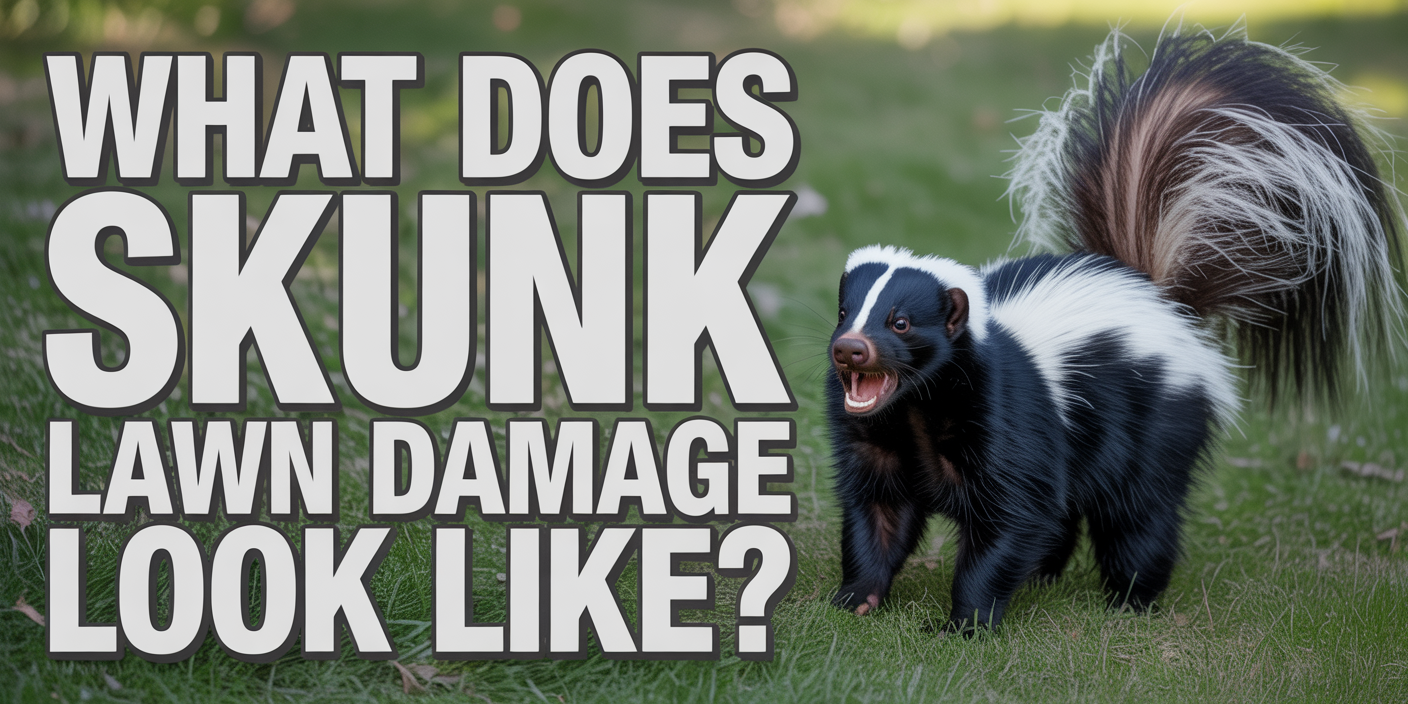Skunk damage often shows up as small cone-shaped holes 3–4 inches wide from digging for grubs. You might also see torn turf, scattered soil, and a faint musky odor in the yard.
Skunks may look harmless from a distance, but your lawn will quickly tell a different story once they start digging. These nighttime foragers love grubs, worms, and insects, which often leads them to tear up soft, moist grass in search of food.
Homeowners who wake up to freshly dug holes or overturned turf often wonder what’s causing the damage. Learning how to identify skunk activity in your yard is the first step to stopping it before it gets worse.
Learn more: How to get a skunk to leave your yard?
What Does Skunk Lawn Damage Look Like?
Skunk lawn damage is most often seen as small, cone-shaped holes about the size of a golf ball scattered across the yard. These holes are shallow, typically 3–4 inches wide, and are created as skunks push their snouts into the soil while digging for grubs and insects.
In addition to the holes, you may notice patches of turf peeled back or rolled up, leaving the soil exposed. Loose dirt scattered across the grass and uneven patches in your lawn are also clear indicators that skunks have been active during the night.
Common Signs of Skunk Digging
Skunks leave behind distinct evidence when they search for food in your yard. The following signs can help you confirm their activity:
- Droppings: Small, pellet-like waste that signals nighttime visits
- Cone-shaped holes: Small, shallow holes about 3–4 inches wide, often clustered where grubs are abundant
- Rolled or lifted turf: Patches of grass peeled back as skunks dig for insects
- Scattered soil: Loose dirt left behind from repeated digging
- Musky odor: A faint, lingering smell near the yard
Together, these signs paint a clear picture of skunk activity in your yard, making it easier to confirm their presence and decide on the next steps for control.
Skunk Lawn Damage vs. Other Animals
It’s easy to confuse skunk damage with the work of other nocturnal diggers, but there are key differences to look for. Skunks typically leave small, neat, cone-shaped holes, while raccoons tend to peel up entire sections of sod in larger patches.
Moles and armadillos also leave distinct signs compared to skunks. Moles create raised tunnels just under the surface, and armadillos dig larger, deeper holes that look more like pits than plugs. Spotting these differences helps you identify the true culprit in your lawn.
Why Skunks Dig in Your Yard?
Skunks are primarily after food, and your lawn offers a buffet of grubs, worms, and insects hiding beneath the soil. When these pests are abundant, skunks will return night after night, leaving a trail of holes and torn turf behind.
They are also drawn to soft, moist lawns where digging is easier. Since skunks are nocturnal, most of this activity happens under cover of darkness, which is why homeowners often wake up to fresh damage in the morning.
Risks of Ignoring Skunk Lawn Damage
Overlooking skunk activity can lead to more than just cosmetic issues in your yard. What starts as a few dug-up patches can escalate into lasting problems for your lawn and even your household.
- Lawn deterioration: Repeated digging weakens root systems, leaving grass thin, patchy, and difficult to repair.
- Weed growth and pests: Bare soil becomes a breeding ground for invasive weeds and secondary pests like beetles or ants.
- Soil erosion: Exposed soil is more vulnerable to runoff and erosion, which can destabilize your yard over time.
- Recurring visits: Skunks return to the same food source, creating ongoing damage and attracting even more wildlife.
- Health and safety risks: Close encounters raise the chance of being sprayed or exposed to diseases skunks may carry.
Ignoring these risks not only harms your lawn but also increases the challenges of keeping your property safe and skunk-free.
How to Prevent Skunk Lawn Damage?
Keeping skunks out of your yard starts with removing the things that attract them in the first place. By cutting off food sources and limiting access to shelter, you make your property far less appealing.
Key prevention steps include:
- Consider professional help: Wildlife control experts can humanely remove skunks and apply long-term prevention strategies.
- Treat your lawn for grubs and insects: Skunks dig mainly to find food, so eliminating grubs reduces their reason to return.
- Secure trash cans: Use tight-fitting lids and keep bins stored properly to avoid attracting skunks at night.
- Remove outdoor food sources: Don’t leave pet food, bird seed, or fallen fruit where skunks can easily find it.
- Use fencing or barriers: Install low fencing or garden netting to protect vulnerable areas like vegetable beds.
- Maintain your yard: Clear away brush, woodpiles, and clutter where skunks might seek shelter.
Protecting Your Yard from Skunks
Skunk lawn damage is easy to spot once you know the signs, from cone-shaped holes to rolled-up turf scattered across the yard. These small but destructive habits are tied to their constant search for food, and without intervention, the damage can quickly spread.
By acting early, you can protect your lawn, reduce future infestations, and avoid unpleasant encounters with skunks themselves. Taking preventative steps or turning to professionals ensures your yard stays healthy, safe, and free from unwanted nighttime diggers.
Protect Your Lawn with AAAC Wildlife Removal!
If skunks are tearing up your lawn, it’s time to call in the experts. At AAAC Wildlife Removal, we provide safe, humane skunk removal and prevention services that stop the digging and protect your yard.
Don’t let skunks ruin your property or put your family at risk of an unwanted spray.




